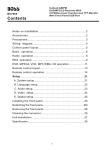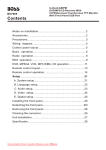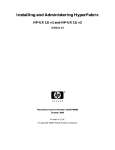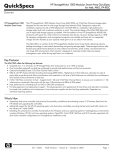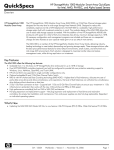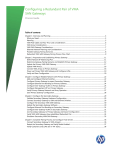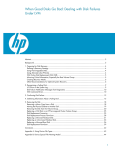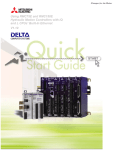Download Introduction to HP-UX 11i v3
Transcript
HP-UX 11i v3 (11.31) Update Training Dec 2007 PARTNER 神州飛黃 © 2007 Hewlett-Packard Development Company, L.P. The information contained herein is subject to change without notice Agenda 1) HP-UX 11i v3 Overview 2) Supported systems and hardware 3) Installation, Update, and Configuration 4) Flexible Capacity Features 5) Secured Availability Features 6) Simplified Management Features 7) Q&A 2 HP Partner 神州飛黃 Release Review Official Name Release Identifier Architecture B.11.11 PA-RISC HP-UX 11i Version 1.5 (v1.5) B.11.20 Intel® Itanium® HP-UX 11i Version 1.6 (v1.6) B.11.22 Intel® Itanium® HP-UX 11i Version 2 B.11.23 Intel® Itanium® HP-UX 11i v2 update 2 (v2UD2) B.11.23 B.11.23.0409 Intel® Itanium® & PA-RISC HP-UX 11i v3 B.11.31 Intel® Itanium® & PA-RISC HP-UX 11i Version 1 3 (v1) (v2) HP Partner 神州飛黃 Purpose of HP-UX 11.31 HP-UX 11i v3 is the next enterprise release delivering expanded infrastructure for the Adaptive Enterprise in a multi-OS world • Competes with IBM's On Demand, Power architecture and AIX • Delivers enhanced performance and feature capabilities for Montecito- based platforms • Delivers the enablers for a more competitive virtualization solution, including both vPars and Integrity VM • Enhanced HP-UX I/O infrastructure for improved scalability, manageability and agility • Improves interoperability with other UNIX systems HP-UX 11.31 fulfills strategy • Targeted at both Itanium-based and PA systems 4 HP Partner 神州飛黃 HP-UX 11i v3 Delivers Leadership Performance Greater than 30% performance improvements over HP-UX 11i v2 on the same server World's fastest and best price/performance TPC-H 10TB benchmark • Measures business intelligence performance • Achieved on a Superdome server with 64 Montecito processors (128 cores) running HP-UX 11i v3 and Oracle 10g R2 • Delivered 171,380 tpmC at a price/performance of $38.98/QphH World's fastest SAP SD 2 Tier benchmark ever • Tests performance of ERP applications • Achieved with HP-UX 11i v3 on an HP Integrity Superdome with 64 Dual-Core Itanium 2 (Montecito) processors and 14 MSA 1000 StorageWorks arrays • Delivered 152,530 SAPs and 30,000 SD users Improved performance • Unified File Cache (UFC) • Enhanced HP Logical Volume Manager (LVM) striping and mirroring • Networking For up-to-the-minute updates on HP-UX 11i performance • Visit www.hp.com/go/hpux11iperformance 5 HP Partner 神州飛黃 HP-UX 11i v3 Delivers Scalability and Availability Increased scalability • Double the number of processes:30000->60000 • PID range:0~1 billion • Increased username/hostname length:8->255 • Larger file size:<=16TB • Larger LVM volume size:<=32TB • More Logical Units (LUNs):<=16384 Mainframe-class UNIX system availability • Hot swap processors and memory Enhanced disaster tolerance and manageability • Modular software selection • Automated PCI I/O recovery • Dynamic Root Disk cloning For up-to-the-minute updates on HP-UX 11i • Visit www.hp.com/go/hpux11i 6 HP Partner 神州飛黃 HP-UX 11i v3 Feature Overview, 1 of 2 Integrated multipathing with the Next Generation Mass Storage Stack • Manages I/O devices, such as SCSI logical units (LUNs) • Enhances server scalability, adaptability, and performance while retaining backward compatibility • New features include – Flexible, agile and manageable LUN addressing – Native multi-pathing – Increased parallelization • Enables enhanced storage scalability – Unlimited number of I/O busses, up from 256 – 16384 LUNs supported per system, up from 8192 active LUNs – LUN size over 2TB – 32 distinct I/O paths to a LUN, up from 8 7 HP Partner 神州飛黃 HP-UX 11i v3 Feature Overview, 2 of 2 New agile view of mass storage • New naming convention for persistent disk and tape device special files • New minor number format that supports much larger I/O configurations • Represents hardware pathing to disk and tape devices New security and availability offerings • Provide increased resiliency, layered security and in-depth protection, and multi-OS management New modular operating environments • Provide more flexibility in managing the products to install and update on a system 8 HP Partner 神州飛黃 HP-UX 11iv3 Supported Systems and Hardware Montecito/Montvale Processor Supported Systems Supported Peripherals Montecito/Montvale Overview Montecito is Intel® Itanium-2 8870, Montvale:9100 Terminology tutorial: • Processor (was socket), • Core • Hyperthread (or hardware thread), LCPU in HP-UX • CPU (it’s too ambiguous) 90 nm version of Madison 2 cores per processor 1-2 hyperthreads per core • Up to 4 hyperthreads (or LCPUs) per processor L3 cache: 24MB (12MB per core) E.g. sx2000 with Montecito – 64 processors , 2 cores per processor, up to 2 hyperthreads per core means 256 max hardware threads (or LCPUs) 11.23 (without HT)─>11.31 (with HT)─> 10 HP Partner 神州飛黃 Blades and Entry-level Servers Blades • All Blades (Itanium) are supported – BL60p blade server • Hurricane, ATCA, Tobruk IPF Entry-level Servers • Onyx, Ruby, Sapphire platforms • IPF Entry-level servers with all supported processors through Mad9 and Montecito – rx2600-2, rx2620 (Long’s Peak) (Also rx1600, rx1620 entry-level server) • 1-2 CPUs, 4 PCI, 2U – rx4640-8 (Mt. Diablo) (Also rx3600) • 1-8 CPUs, 6 PCI, 4U, 64 GB memory, 3MB L3 cache/6MB L3 cache – rx5670 (Everest) • 1-4 CPUs, 10 PCI, 7U, 96 GB memory – Nemesis, Pearl, BadgerPeak PA Entry-level Servers • rp3410-2, rp3440-4 with PA-8800 (800 MHz and 1 GHz) • StormPeak with Mako and Shortfin processors 11 HP Partner 神州飛黃 Mid-range Servers IPF Mid-range servers • rx6600 • rx7620, rx7640 (Eiger) and rx8620, rx8640 (Olympia) with Madison, Hondo, and Mad9 IPF processors • Mittelhorn/IPF and Kona/IPF PA Mid-range servers • rp4440 (Mt. Hamilton), rp7420 (Medel), rp8420 (Rainier) – with Mako and Shortfin (a.k.a. Mako+) PA processors • rp7405, rp7410 (Matterhorn), rp8400 (Keystorne) w/ firmware 16.8 or later • Mittelhorn/PA and Kona/PA within 6 months of initial SR 12 HP Partner 神州飛黃 High-end and Cell-based Servers Integrity High-end servers HP Integrity Superdome (Orca/IPF through Mad9) – Significant bus bandwidth improvements from PA-RISC – Support Management Station (SMS) is Windows 200x PC • All SandDune/IPF PA-RISC High-end servers • All PA Superdomes (Superdome, Caribe, Pacu, Orca/PA) • All SandDune/PA, Shortfin, Mittelhorn processors within 6 months of initial SR 13 HP Partner 神州飛黃 Cell-based systems and ccNUMA Support HP's cell-based platforms are ccNUMA • ccNUMA = cache coherent, Non-Uniform Memory Access • Latency and bandwidth of a same-cell memory access is better than accessing memory on a different cell For ccNUMA platforms, HP-UX 11i v3 is ccNUMA-aware • Maintains good behavior for applications that are not ccNUMA-aware • Gives ccNUMA-aware applications the ability to control their memory placement as well as processor placement Core feature of HP-UX 11i v3 14 Hp Partner 神州飛黃 Unsupported Servers and Workstations Unsupported systems • All 32-bit PA-RISC servers • All Itanium-1 based systems (rx4610, rx9610, i2000) Unsupported PA-RISC servers • High-end (same as HP-UX 11i v2) – All T-Class servers – All V-Class servers • Mid-range – N-class (rp7400) – All K-Class servers (same as HP-UX 11i v2) • Low-end – All D-Class, E-Class, and R-Class servers (same as HP-UX 11i v2) – All A-class servers (A180/A180C, rp2400, rp2405, rp2430, rp2450, rp2470) – All L-Class servers (rp5400, rp5405, rp5430, rp5450, rp5470) Unsupported workstations • No PA-RISC or Integrity workstations (zx2000, zx6000) are supported 15 HP Partner 神州飛黃 I/O cards shipping on HP-UX 11i v3 Card Type Description Mass Storage 2G FC Tachlite; 2-port 2Gb FC; 2 port U320 SCSI U160 RAID - SmartArray 5304 (PA only) SmartArray 6402 2-channel and 6404 4-channel RAID 1-port and 2-port 4Gb FC card PCI-X Networking 4-port 10/100B-TX (A23); 10/100B-TX (RJ45) Next Gen 1000B-T and –SX (5701 chip) 1000BaseSX and T Dual Port (Intel chip) 10G Ethernet; 4-port 1000B-T Ethernet; 2-port serial (X25/FR/SDLC) PCI/PCI-X 1-port 1000Base-T and –SX Adapter Cluster Hyperfabric II; PCI-X 2-Port 4X InfiniBand HCA (HPC), RoHS PCI-X 2-Port 4X InfiniBand HCA w/ HA and Database Support, RoHS Combo PCI-X 1000Base-SX and –T GigE / 2G FC Combo U320 SCSI/GigE Combo Card PCI-X 2-port 1000B-T/2-port 2Gb FC Combo 1 port and 2-port 4Gb FC & 1 port and 2-port GigE HBA PCI-X Other 8-port and 64-port Terminal MUX (MR: 3/01) 8-port and 64-port Terminal MUX 16 Hp Partner 神州飛黃 Special I/O cards and legacy cards Card Type Description Special Obsidian USB/VGA PCI card (IPF only) Procurium GigE LAN/SCSI combo card SAS card (Core for RuSa) (IPF only) 1000BaseT Dual Port (Core only) ATI Radeon 7500 PCI Graphics Card Specials (OCBU): 8 ports ACC (A13) Cards not on CPL, but still supported on HP-UX 11i v3 Networking: Gigabit Ethernet (1000B-SX); Gigabit Ethernet (1000B-T) Mass Storage: FCMS – Tachlite; 1 port U160 SCSI; 2 port U160 SCSI Cluster: PCI-X 2-Port 4X InfiniBand HCA (HPC) and w/ HA & DB supp No longer on CPL, and not supported on HP-UX 11i v3 Cluster: Hyperfabric (PCI 1X); HiPPi 800 (A4) Combo: 2port Ultra2-SCSI + 2port 100T Mass Storage: FCMS – Tachyon; FWD SCSI; 2-port Ultra2 SCSI; 2-port FWD SCSI; 2-port FWD SCSI; RAID 4Si Networking: 10/100B-TX (AUI, BNC, RJ45); FDDI Dual Attach; Ultra2 SCSI; 100B-FX; ATM 622 (MMF connector); ATM 155 (MMF connector); ATM 155 (UTP5 connector); Token Ring (4/16/100 Mb/s); Intel 82559 100BT; 4-port serial (X25/FR); ATM 155 MMF (V Class only) Other: PKC (Public Key Cryptography) (A3); 8-port Terminal MUX; 64port Terminal MUX Hp Partner 神州飛黃 17 HP-UX 11iv3 System Installation, Update, and Configuration Operating Environments on HP-UX 11i v3 Foundation OE • Web, content, and front-end servers Enterprise OE • Database application and logic servers • Foundation OE plus – EMS HA monitors, MirrorDisk/UX, OV GlancePlus, PRM, Online JFS Mission Critical OE • Application servers and database servers • Enterprise OE plus – ServiceGuard and ServiceGuard NFS – Workload Manager and Workload Manager Tookit – ECM Toolkit Technical Computing OE • Server applications using graphics applications and math libraries No Minimal Technical Computing OE 19 HP Partner 神州飛黃 HP-UX 11i v3 Packaging – Operating Environments Operating Environment • Items noted under OEs are individual bundles and are de- selectable Terminology change to Required, Recommended and Optional • Required are always selected and installed • Recommended and optional products are de-selectable for cold install and update Core is split into multiple bundles • One Required, one Optional and the rest Recommended • Allows customers more flexibility in what they load and maintain 20 HP Partner 神州飛黃 Additional OE Highlights to Note CDE is now Optional • English was required in previous HP-UX releases • Need to specifically select CDE now New localized bundles • HPUXLocales • Extn and Man bundles • Split out of main core bundle and can be deselected New category tags • Previous releases just had OrderedApps – All application products were here on Ignite-UX menu • 20+ new categories – Including SupportTools, SystemManagement, CompilersDevelopment, DisksFileSystems, Localization, Manuals 21 HP Partner 神州飛黃 Major Installation/Update Differences Update from HP-UX 11i v2 only • Not from HP-UX 11i v1 Disk Space Requirements have grown • Different enough to cause problems when updating 22 HP Partner 神州飛黃 Installation Configuration Requirements To cold-install or update to HP-UX 11i v3, you must have • Supported HP-UX system • • • • – Itanium-based servers include HP Integrity cx2600, rx16x0, rx26x0, rx3600, rx4640, rx5670, rx6600, rx76x0, rx86x0, rx9610, Superdome, BladeSystems BL60p – Several Dual-Core Intel Itanium(2) HP Integrity and Superdome servers – PA-RISC servers include rp34x0, rp4440, rp74xx, rp84x0, HP 9000 Superdome – No workstation support Cold-install or update HP-UX 11i v3 software sources – HP-UX 11i v3 OE and Application (AR) media (DVDs) – SD Network Depot – Ignite-UX server 1 GB memory, minimum 1 GB swap space, minimum Approximately 24 GB of disk space to install server OEs Note that documented minimums may be low compared to typical actual configurations 23 HP Partner 神州飛黃 Disk Requirements Comparison File System HP-UX 11i v2 Size HP-UX 11i v3 Size /usr (71% used) 2.6-3.7 GB 3.8 GB /stand (7% used) 1.9 GB 304 MB /var (3% used) 4.5 GB (unless MTOE 8.5 GB (No MTOE) which is 1.5 GB) /tmp (4% used) 208 MB /opt (58-61% used) 2.7-4.5 GB /home (5% used) / (29% used) 230 MB 24 512 MB 4.7-5.8 GB 32 MB (unless MTOE 112 MB (No MTOE) which is 20 MB) HP Partner 神州飛黃 1 GB Cold Install or Update? Update from HP-UX 11iv 2 (B.11.23) Servers only • Update to same HP-UX 11i v2 OE or higher OE • Updating from HP-UX 11i v1 is not supported • Tool: msv2v3check Update Advantage • Retain user data, configuration, and applications Cold-install supported from any supported configuration • See the Installation Configuration Requirements above Cold Install Advantages • Use of Ignite-UX server makes clean standard configurations easy – Use of Ignite-UX overwrites everything on the target volume • Partitions will be sized for 11.31 – Updating usually means that you will have to increase some file system partition sizes 25 HP Partner 神州飛黃 HP-UX 11i v3 Hardware Paths Agile View • Reliability, Adaptability, Performance, Scalability • Dynamically change paths to device • Multiple paths to a device treated like single virtualized path – I/O distributed across the multiple paths Types of paths to a device • Legacy Hardware Path – Used in releases prior to 11.31 – Bus-nexus addresses separated by / leading to HBA, additional address elements separated by . • Lunpath Hardware Path – Use more targets and LUNs – Additional address elements printed in hex • LUN Hardware Path – Virtualized path representing all the lunpaths to a single LUN – Virtual bus-nexus (virtual root node address of 64000) • 64000/0xfa00/0x22 26 HP Partner 神州飛黃 Differences in the Cold-Install to HP-UX 11i v3 Root, dump, and swap devices configured with new agile addressing PA-RISC BCH search command displays only legacy hardware paths Root Disk screen displays lunpath hardware path instead of the legacy hardware path On Languages screen, mark Yes for HPUXLocales CDE is an optional product in HP-UX 11i v3 • If you require it, you must explicitly select the CDE bundle Select and deselect software bundles on the Additional Software screen • HP-UX 11i v3 offers several product categories – Each product category contains software components that are marked as required, recommended, or optional 27 HP Partner 神州飛黃 Device Special Files: Installing and Updating DSFs: Installing and Updating • Cold-install – Automatically creates legacy and persistent DSFs – Uses persistent DSFs for boot, root, swap, and dump devices • /etc/fstab, /etc/lvmtab, et. al. refer to persistent DSFs • Update – Retains existing legacy DSFs • Backward compatible, not affected by persistent DSFs – Creates persistent DSFs – Allows simultaneous access to device using legacy and persistent DSFs See “The Next Generation Mass Storage Stack: HP-UX 11i v3” at http://docs.hp.com 28 HP Partner 神州飛黃 Tasks Prior to Cold Installing HP-UX 11i v3 Select an HP-UX Console if needed • Itanium-based systems only Back up any configuration files you want to reinstall • • • • • Configuration files in /etc The contents of /usr/local Any local home directories (that is, those you do not import from another system) Any configuration files located in the /etc/opt directories for installed software Back up your system • Use any supported HP-UX backup software • Also, create an OS recovery image Update your Ignite-UX server • If you intend to use Ignite-UX to cold-install HP-UX 11i v3 on more than one system Locate source media and code words Refer to HP-UX 11i v3 Installation and Update Guide • Information on console selection is especially useful 29 HP Partner 神州飛黃 More Tasks Prior to Cold-Installing HP-UX 11i v3 Ensure system meets system requirements to install and operate HP-UX 11i v3 • File system sizes and disk size are especially important! Complete preparation tasks covered on the previous slide • Create an operating system recovery image to protect your data in the event of a system crash Collect available networking information and other system specific data • Refer to Installation and Update Guide for useful tables 30 HP Partner 神州飛黃 Installation Steps - Overview Boot system, interrupt autoboot Load and run install kernel – See IUG for detailed instructions for both PA and IPF systems Select User Interface and Media Options – UI options – Guided, Advanced, and Default without UI – Media options – Media only, Media with network, Ignite-UX server Configure networking if needed – After filesets are copied to disk and system reboots, set_parms may run If Guided or Advanced install, follow prompts – Advanced allows you to specify OE, root disk, file system type, swap size, software, timezone, network parameters, root password, file system sizes, etc. Perform post-load configuration – Set network, language, etc. – Can be bypassed if selected prior to fileset loading 31 HP Partner 神州飛黃 Differences in the Cold-Install to HP-UX 11i v3, 1 of 3 Root, dump, and swap devices • Configured with new agile addressing representation • Use persistent DSFs – Although both legacy and persistent DSFs are created PA-RISC boot console search command displays only legacy hardware paths • You can specify either hardware path in Boot command Root Disk screen displays lunpath hardware path instead of the legacy hardware path • Select More Info to view legacy hardware path for selected root disk • The lunpath hardware path selected is used only to identify the Root Disk itself • Any available path to that disk may then be used as boot path – Normal to see a different lunpath hardware path to the disk used as boot path 32 HP Partner 神州飛黃 Differences in the Cold-Install to HP-UX 11i v3, 2 of 3 If you select VxVM or LVM on the File System Type screen • Then root disk cannot be moved to another SCSI bus or address that results in a change in the hardware path to the device – If it is moved, you may not be able to boot safely from it On Languages screen, mark Yes for HPUXLocales and verify language choice • Locale settings moved from CDE language bundle on HP-UX 11i v2 to HPUXLocales bundle on HP-UX 11i v3 CDE is an optional product in HP-UX 11i v3 • If you require it, you must explicitly select the CDE bundle (CDE-XXX) – This applies if you need dtterm, which is located in CDE • For some localization situations, dtterm is required 33 HP Partner 神州飛黃 Differences in the Cold-Install to HP-UX 11i v3, 3 of 3 Select and deselect software bundles on the Additional Software screen • HP-UX 11i v3 offers several product categories – Each product category contains software components that are marked as required, recommended, or optional • HP recommends NOT deselecting recommended bundles or removing them from your system unless you know for certain that the software contained in these bundles are not required for your operating environment 34 HP Partner 神州飛黃 Selecting and Deselecting Software Bundles 35 HP Partner 神州飛黃 Updating to HP-UX 11i v3 Process is similar to HP-UX 11i v2 • Install the latest update-ux(1M) program • Run update-ux Supports the HP-UX 11i v3 update paths • From HP-UX 11i v2 on both PA and Itanium-based systems • Checks made for supported hardware update-ux is similar to previous versions • New –i option invokes swm TUI • New –p option runs analysis only Bundles for selected OE will be automatically selected if you specify an OE at invocation • Choose other packages/bundles as desired 36 HP Partner 神州飛黃 Update-ux – New TUI 37 HP Partner 神州飛黃 Verifying the Install/Update Using Logs Changed log file on HP-UX 11i v3 • HP-UX 11i v2 log file is /var/adm/sw/swagent.log • HP-UX 11i v3 log file is /var/opt/swm/swm.log Carefully review contents of /var/opt/swm/swm.log • Pay particular attention to ERROR and WARNING messages • You’ll get LOTS of NOTE messages on Update • Not everything will appear in the log – Bastille bundle selection, for example 38 HP Partner 神州飛黃 Verifying the HP-UX 11i v3 Cold Install or Update Using SW Tools List all software installed on the system • Check that all bundles/products/filesets are installed /usr/sbin/swlist –l [bundle | product | fileset] swlist –l bundle –l product > /tmp/software_list • Check the list for products and bundles you desire • For cold install, compare to OE and App DVDs swlist –l bundle –l product –s /dvdrom > /tmp/dvdcontent Verify that packages are intact /usr/sbin/swverify \* • Check /var/adm/sw/swverify.log and /var/adm/sw/swagent.log 39 HP Partner 神州飛黃 Post-Install Tasks, 1 of 3 Configure OE applications • Check log file for messages regarding required changes Migrate to Agile Mass Storage Stack, if desired • Installing causes both legacy and persistent DSFs to be created • Installing configures system devices to use persistent DSFs – Boot, root, swap, and dump devices • Configuration files use persistent DSFs – /etc/fstab, /etc/lvmtab 40 HP Partner 神州飛黃 Post-Install Tasks, 2 of 3 Retrieve information after cold installing • Create a new root home directory, e.g. /homeroot – Modify /etc/password – Move root’s dot files to /homeroot • Recover files – Logout and log back in as root – Manually merge your previously saved files • Restore your local home directory, e.g. /home – Copy it back from another directory or tape where you stored it • Restore other files 41 HP Partner 神州飛黃 Post-Install Tasks, 3 of 3 Install other OE applications New versions of configuration files/scripts are loaded • If any of these were modified, modifications will have to be reapplied 42 HP Partner 神州飛黃 New Software Deployment Tool – Software Manager (swm) Provides a CLI and TUI to manage software, including bundles, products, sub-products and filesets • Similar to SD commands except swm is a single command with major modes Extends functionality provided by SD • And has the ability to update from one operating environment to another Has four major modes of operation • ‘swm install’ installs software • ‘swm list’ lists software • ‘swm job’ provides job control interface to existing jobs • ‘swm oeupdate’ updates an operating environment 43 HP Partner 神州飛黃 Ignite-UX v C.7.0 on HP-UX 11i v3 Multipath-Aware Ignite • Is aware of all hardware paths leading to a device Operating Environments restructuring affects Ignite-UX • Software products grouped as “Required,” “Recommended,” and “Optional” Integrates with SWM rather than SD for software installation tasks User selectable archive format for recovery archives and golden archives Ignite-UX checks minimum memory requirements • Will not permit installation or recovery to proceed if the system is below the memory limit Ignite-UX bundle structure has been changed 44 HP Partner 神州飛黃 Dynamic Root Disk (DRD) on HP-UX 11i v3 DRD Software deployment tool improves the OE update experience DRD safe software packaging • Enable HP-UX software to be patched and updated while the system is doing productive work during normal business hours Software deployment tools enhanced • Support improvements to the HP-UX Operating Environments Provides the ability to create and manipulate an inactive system image • Inactive system environment is a bootable system environment that is not currently in use by the running system Software packaging changes made to support DRD • Generate backward compatible packages that work with or without DRD New software packaging attributes and environment variables are added for DRD safe packaging 45 Hp Partner 神州飛黃 Dynamic Root Disk (DRD) on HP-UX 11i v3 Provides the ability to create and manipulate an inactive system image • Inactive system environment is a bootable system environment that is not currently in use by the running system – Used for a variety of purposes • Recovering system in event of failure • Preparing new system environment while preserving existing system environment Software packaging changes made to support DRD • Generate backward compatible packages that work with and without DRD New software packaging attributes and environment variables are added for DRD safe packaging • An attribute to indicate that software package is safe for install to an inactive DRD environment • An environment variable to indicate that the package is being installed or managed in a DRD modification environment 46 Hp Partner 神州飛黃 PCI Card On-line Deletion on HP-UX 11i v3 PCI card OLD allows deleting PCI cards and associated drivers without requiring a system reboot • PCI OLAR on HP-UX 11i v2 enhanced to include deletion • Now, full PCI OL* 47 Hp Partner 神州飛黃 HP-UX 11iv3 Flexible Capacity Features 48 Hp Partner 神州飛黃 Performance and Scalability on HP-UX 11i v3 Support Montecito processor features on Integrity systems • Allow 256 hardware threads Larger memory configuration • Up to 2TB and pre-enabled up to 4TB Increased file system and file sizes • File system sizes up to 32 TB and file sizes up to 16 TB Performance monitoring system tools and interfaces • Processor performance monitoring tool, perfmon • Mercury library, libhg*, enables user programs to measure performance • sar and pstat reporting enhancements • Kernel instrumentation enhancements – Used by OpenView GlancePlus, OpenView Performance Agent, Prospect, and sar(1M) command 49 Hp Partner 神州飛黃 HT and LCPU Enablement Summary HT can only be enabled and disabled in firmware at system boot • Firmware setting used to turn on/off hyper-threading for the entire machine statically at boot LCPUs can be enabled and disabled dynamically at the granularity of a processor set (pset) • Provides a “safe-haven” for applications that prefer single-threaded hardware – Real-time, high performance technical apps, etc. • Disabled LCPUs are parked in firmware in a power saving mode For a customer to use HT • HT must be enabled at boot in firmware • AND • LCPUs must be enabled dynamically in HP-UX State of HT and LCPU enablement persists across reboots 50 Hp Partner 神州飛黃 Virtualization Technology A set of hardware enhancements to Intel platforms • VT-i refers to the Intel Itanium architecture and processor virtualization enhancements Designed to simplify virtualization software • HP Integrity VM is HP’s software virtualization machine Virtualization brings new end user value and new differentiation opportunities • Sufficient isolation between different virtual machines • Uncompromised performance of each virtual machine • Availability, reliability, and security of the entire platform 51 Hp Partner 神州飛黃 PCI On Line Deletion (PCI OLD) PCI OL* is an HA feature for interface cards • Is core HP-UX functionality • Minimizes customer risk and downtime • Allows “hot-plugging” of I/O cards – Eliminates the need to reboot • On Line Deletion is new on HP-UX 11i v3 Flexible Capacity Benefits of the new PCI OLD feature • Remove bad cards • Move card resources from one Peripheral Device to another • Move card resources from one vPar to another • Remove card and replace with a different card • Perform Cell OL* – Coming in an HP-UX 11i v3 update 52 Hp Partner 神州飛黃 HP-UX 11i v3 Dynamic Resource Reconfiguration Features Memory migration between Integrity VM guests Dynamic memory migration between vPars guests Cell OLA to nPars Cell OLA to Integrity VM host Cell migration between nPars Cell migration between Integrity VM hosts Cell OLD with physical removal from nPar Cell OLD with physical removal from Integrity VM host Cell OL* delivered post-LR in later HP-UX 11i v3 update Integrity VM has a separate release schedule 53 Hp Partner 神州飛黃 Dynamic Resource Reconfiguration & Cell OL Dynamic Resource Reconfiguration • Ability to change hardware resources used by OS instances – Improves resource utilization – Satisfies application service level agreements Cell OL A/D • Coming with HP-UX 11i v3 Sep 2007 update release • Dynamically add/delete cell board to/from running OS instance – Cell board includes CPUs, memory, and (optionally) I/O – Includes when cell is physically inserted/removed and when cell is logically reassigned • Cell iCAP and Cell migration 54 Hp Partner 神州飛黃 Cell On Line Deletion, 1 of 2 Coming on HP-UX 11i v3 • A cell can be deleted from an nPar while the OS runs – Earlier releases require a reboot for the deletion to take effect • Deleted cell must be a floating cell • If cell is attached to I/O expander, all PCI cards must have been deleted using PCI OLD commands Applies only to a cellular complex • rp7420, rp7440, rp8420, rp8440, rx7620, rx7640, rx8620, rx8640 • HP 9000 Superdome servers – Includes SD16A, SD32A, and SD64A models – Does not include SD16000, SD32000, and SD64000 models • HP Integrity Superdome – SD16A, SD32A, and SD64A, SD16B, SD32B, and SD64B 55 Hp Partner 神州飛黃 Cell On Line Deletion, 1 of 2 Cell OLD and tunables • Memory based tunables adjusted as part of OLD operation Cell OLD reduces resources in an nPar • Performance capacity diminished proportionately New command performs cell OL* operations • parolrad(1M) Documentation – Man pages for parcreate (1M), parmodify (1M), parstatus (1M), parolrad (1M) – HP System Partitions Guide Administration for nPartitions 56 Hp Partner 神州飛黃 HP-UX Instant Capacity (iCAP) Single Physical Node Cell Board instant Capacity CPU instant Capacity Temporary instant Capacity e.g. single 8-core HP Integrity rx7620 Inactive cell board containing four dormant CPUs One or more inactive CPUs per cell board Temporary use (30 days/ 720 hours) of CPU time HP rp7410 Cell Board 1 Cell Board A A A A RAM RAM RAM RAM A A AI I Cell Board 2 AI AI I A = Active I = Inactive I RAM RAM RAM RAM RAM RAM RAM RAM Granularity / Flexibility 57 Hp Partner 神州飛黃 I A I Understanding WBEM and EVM WBEM is HP’s strategic management infrastructure • Is industry standard • Ties together multiple HP-UX, Linux, & Windows systems • Provides secure distributed management • Includes object instances, methods, and indications (events) EVM is HP-UX’s lightweight event handling system • Provides HP-UX-specific event subscription and notification interfaces • • • • • 58 and an event delivery mechanism Unifies HP-UX low-level kernel and user space events Is usable within the kernel and in single user mode Is optimized for events – Does not support instances or methods Has interfaces that are callable from C and shell scripts – Interfaces are non-standard Events are available as WBEM indications via the EVM CIM provider Hp Partner 神州飛黃 HP-UX 11i v3 Mass Storage Stack Re-architected Mass storage stack Key Features • Native multi-pathing built-in • Agile device files based on LUN WWID addressing • Device files and dev_t and path/location independent – dev_t fully opaque • No longer encodes path (cXtYdZ) or device specific options in minor number • New features for management and trouble-shooting 59 Hp Partner 神州飛黃 HP-UX 11i v3 to 11i v2 I/O Stack Comparison Product/Functionality HP-UX 11iv3 HP-UX 11i v2 Max LUNs per system – Architectural 16M 32K Max LUNs per system – tested 16K 8K 32 8 Max LUN paths per system - tested 64K 16K Max storage controllers (bus instance limits) 16M 256 Native Multi-Pathing & Load Balancing Yes No Dynamic LUN size expansion Yes No Automatic Device Discovery Yes No Agile Addressing Yes No Max paths per LUN - tested 60 Hp Partner 神州飛黃 Agile Addressing and Multi-pathing Overview Agile Addressing • Also known as Persistent LUN Binding • Persistent Device Special Files • New naming convention for mass storage devices • Virtualized hardware path for multi-pathing Multi-pathing • Built-in multi-pathing • Transparent load balancing – Choice of load balancing algorithms • Automatic handling of path and device changes • Integration with management software • Health tracking of mass storage devices 61 Hp Partner 神州飛黃 Table of Persistent and Legacy DSF Names Persistent DSF Name /dev/disk/disk# Legacy DSF Name Description /dev/dsk/c#t#d# The entire disk (block access) /dev/rdisk/disk# /dev/rdsk/c#t#d# The entire disk (raw access) /dev/disk/disk#_p# /dev/dsk/c#t#d#s# Partition on the disk (block access) /dev/rdisk/disk#_p# /dev/rdsk/c#t#d#s# Partition on the disk (raw access) /dev/rtape/tape#options /dev/rmt/c#t#d#options /dev/rchgr/autoch# 62 Tape device (raw access) /dev/rac/c#t#d#_options Autochanger device (raw access) Hp Partner 神州飛黃 Hardware Pathing on HP-UX 11i v3, 1 of 3 Three different types of paths to a device • Legacy hardware path • Lunpath hardware path • LUN hardware path Paths are numeric strings of hardware components • Each number represents location of a component on the path to the device Legacy hardware path • Series of bus-nexus addresses separated by /’s leading to a host bus adapter (HBA) • Components below HBA are separated by .’s • 0/0/2/0.1.7.0 63 Hp Partner 神州飛黃 Hardware Pathing on HP-UX 11i v3, 2 of 3 Lunpath hardware path • Used for mass storage devices, or LUNs • Format printed by agile view • Series of bus-nexus addresses separated by /’s leading to a host bus adapter (HBA) • Components below HBA are in hex – Leading element(s) represent transport-dependent target address – Final element is a LUN address • 64-bit representation of LUN id reported by target • Examples – Fibre Channel (FC) • 0/2/1/0.0x50001fe1500170ac.0x4017000000000000 – SCSI • 0/1/1/0.0xd.0x0 • Looks like legacy, except that the last two numbers are in hex 64 Hp Partner 神州飛黃 Hardware Pathing on HP-UX 11i v3, 3 of 3 LUN hardware path • Virtualized path representing all lunpaths to a single LUN • Printed in agile view • Virtual bus-nexus with an address of 64000 • Addressing below the virtual root node – Virtual bus address / Virtual LUN identifier • Example – 64000/0xfa00/0x22 Virtualized path implications and benefits • LUN hardware path is handle to LUN – Does not represent the LUN’s physical location • Linked to the LUN’s World Wide Identifer (WWID) • LUN binding is persistent – Across physical path changes and across reboots 65 Hp Partner 神州飛黃 Changes to I/O Commands ioscan – Displays views of I/O hardware & devices insf – Creates device files for adapters & devices mksf – Creates device file for specific device lssf – Displays device & dsf information rmsf – Deletes the DSF, or I/O nodes ioinit – Allows modification of ioconfig file • Allows online reassignment of instances if driver supports it via -f option – User specifies file containing information on list of instances to be reassigned – Limitation that number of entries in file cannot exceed 14 at a time • Call ioinit several times to reassign more than 14 instances online iofind – Migrates old DSFs to new style persistent DSFs iobind – Changes driver binding io_redirect_dsf – Allows transparent device replacement 66 Hp Partner 神州飛黃 Display legacy hw path, lunpath hw path, and LUN hw path Mappings 67 Hp Partner 神州飛黃 New scsimgr Command 68 Hp Partner 神州飛黃 scsimgr get_attr –D <disk DSF> settable 69 Hp Partner 神州飛黃 scsimgr get_attr –H <hardware path> 70 Hp Partner 神州飛黃 USB-00 Subsystem and Device Drivers Dynamically managed device file system • Dynamic device special file creation and removal Additional USB features • Plug-and-play of USB devices • Support for mass storage drivers – USB CD-ROM/RW – DVD-ROM/+RW • Boot/install from HP USB DVD devices Supports mass storage encryption Dynamically extensible • Allows for fast development of new USB device drivers • Object-oriented run-time infrastructure Replaces legacy USB stack previously in various drivers • HCD, HUB, HID, USBD legacy drivers removed 71 Hp Partner 神州飛黃 File System Tunables Changes on HP-UX 11i v3 More tunables converted to dynamic • No need to reboot improves availability Agility Several tunables made automatic • Memory changes cause tunable change Usability issues addressed • Unit tunables: percent(%), suffixes (K/KB/M/MB/GB) Number of tunables reduced by more than ten • Made private, deprecated, obsoleted, or removed Simplicit y 72 Hp Partner 神州飛黃 Capacity Expansion Value HP-UX File / File System Sizes Architectural FS Size File Size 11iV1 2TB 2TB Tested Individual FS Size File Size FS limits 2TB 2TB % HFS –128GB; VxFS - 2TB; 11iV2 8EB 2TB# 32TB 2TB % HFS – 128GB; VxFS3.5 – FS 32TB, F 2TB; 11iV3 8EB 8EB VxFS - 32TB* VxFS - 16TB* % HFS – 128GB; VxFS4.1 – 8EB; 11.XX 8EB 8EB * Qual targets 73 Customer driven # OS – 8EB Customer driven VxFS4.1 – 8EB; % HFS deprecated Hp Partner 神州飛黃 Unified File Cache (UFC) Overview Integrates page cache and buffer cache Provides coherency when accessing a file using both read(2)/write(2) and mmap(2) system calls simultaneously • The read/write file system calls used the buffer cache to cache file data prior to HP-UX 11i v3 • The mmap system call used the page cache before HP-UX 11i v3 Enables ports of NFS ONC 2.3 and VxFS 4.1 Improves compatibility with other Unix-based OSs Potential performance improvements 74 Hp Partner 神州飛黃 LVM on HP-UX 11i v3 LVM has key improvements for HP-UX 11iv3 • • • • • • Full support of the new re-architected mass storage stack New Features Improved scalability Increased performance Improved System Management Improved High Availability features Providing key features and functionality in the following areas New Features Scalability Performance Manageability High Availability • RAID (0 + 1) • RAID (1 + 0) • Dynamic LUN Expansion Support • VG Modify • Increased Logical Volume Size • Increased default VG Values • Large I/O support • Performance Tuning • Fine Grain Striping support • FSWEB integration • Volume Group Suspend • Improved CLI display commands • Support for Legacy and new DSF’s • EMT Support • Disk OLR • Improved Error detection • Improved Mirror Recovery • Online Cluster Reconfiguration 75 Hp Partner 神州飛黃 Process Management Interface Expansion Range of PIDs increased from max of 30,000 to 1,073,741,823, which is 2^^30-1 Dynamic kernel tunable – nproc • New maximum value stated to be 256,000 Limit on username and groupname lengths expanded • Now 255 bytes, up from 8 bytes and 16 bytes Longer node names supported • New limit up to 255 bytes from previous 8 byte limit Longer hostname supported • New limit up to 255 bytes from previous 64 byte limit 76 Hp Partner 神州飛黃 HP Virtual Partitions (vPars) A.05.01 New features in vPars in HP-UX 11i v3 • Dynamic, online memory migration • Montecito hyperthreading support • Mixing A.04.02 and A.05.01 virtual partitions in same vPars environment Integrates with HP-UX dynamic solutions • EVM, iCAP, PPU, PCI OL*, WLM, PRM • Limited VSE manager (read configuration only) • Future Fusion releases – VSE manager integration 77 Hp Partner 神州飛黃 HP-UX 11iv3 Secured Availability Features 78 Hp Partner 神州飛黃 PCI Error Recovery – New on HP-UX 11i v3 Detect, isolate, and automatically recover from PCI error • Avoids system crash When error occurs on PCI bus with I/O card supporting PCI Error Recovery, automatic recovery steps are taken • Isolate PCI bus from the rest of the system • Attempt recovery from error – Keep bus and I/O card quiesced if a nested error occurs • Re-initialize the bus 79 Hp Partner 神州飛黃 System Fault Manager (SFM) Supported on all systems that support HP-UX 11i v3 Collection of tools used to monitor the health of HP servers • Memory, CPU, power supplies, and cooling devices Operates in the WBEM environment • WBEM indications can be logged in syslog Features include • Event Manager – Common Information Model Provider (EVM-CIM) • Error Management Technology (EMT) Features not available on initial HP-UX 11i v3 release • SFM Indication Provider – Use EVWeb Event Viewer to view equivalent indications • EVWeb Log Viewer HP threshold indications equivalent to indications generated by High Availability Monitors are now supported • View HP threshold indications using the EVWEB Event Viewer 80 Hp Partner 神州飛黃 Accessing HP-UX Error Messages HP-UX 11i v3 HP-UX 11i v2 Accessing HP-UX error message information: Accessing HP-UX error message information: Go to HP ITRC website and search on error message Online HP-UX error utility on each Customer system Examine each document returned Consolidated error information HP-UX 11i v3 release and onwards Search may return: HPUXERR01 This is the outdated HP-UX Error Message Catalog Manual that does not contain information on HP-UX Releases after January 1991 Document is limited in scope 81 Cause and action text provided for errors Hp Partner 神州飛黃 EMT GUI integrated with SMH Simple Search Advanced Search 82 Hp Partner 神州飛黃 Custom solution administration Livedump on HP-UX 11i v3 Availability Performs a crashdump on a live system without a forced shutdown or panic of that system • Itanium-based platforms only Use livedump to obtain a memory dump of the system • System stays up and running, remaining stable • Allows for subsequent offline analysis of system Performance impact • Saves the memory onto a file system – Causes extra system load during this save Documentation • livedump(1M) man page 83 Hp Partner 神州飛黃 Dump time reduction on HP-UX 11i Releases In HP-UX 11i v1 and HP-UX 11i v2 • Two features to reduce system dump times – Selection • Reduces the size of the memory to be dumped – Compression • Reduces the size of the data that needs to be written to disk In HP-UX 11iv3 • New third mechanism added – I/O parallelism • Increases the rate at which the data can be written to disk 84 Hp Partner 神州飛黃 Cache File System - CacheFS CacheFS is a general purpose file system caching mechanism • Improves NFS server performance and scalability by reducing server and network load How does CacheFS work? • Data is cached on local disk when it is read from an NFS mounted file system • Subsequent read requests are satisfied from the local disk cache How is performance improved? • Local disk caching of remote NFS-served file systems reduces network traffic • Reduced access requests to the server increases the server's performance and allows more clients to access the server Performance improvements are dependent on the type of file system access • Good for file systems where data is read more than once CacheFS on HP-UX 11i v3 was ported from Solaris ONC+2.3 code 85 Hp Partner 神州飛黃 Identity Management on HP-UX Data Repositories • Red Hat Directory Server (LDAP Server) • LDAP-UX Integration (LDAP Client) Authentication Services • HP-UX Identity Management Integration (HP IdMI) • HP-UX Select Access for IdMI (HP SA-IdMI) Authorization Services • HP-UX Identity Management Integration (HP IdMI) • HP-UX Select Access for IdMI (HP SA-IdMI) • HP-UX Role Based Access Control (HP RBAC) All are free on HP-UX 86 Hp Partner 神州飛黃 HP-UX 11iv3 Simplified Management Features 87 Hp Partner 神州飛黃 HP System Management Homepage (HP SMH) Overview Web-based system administration tool for managing HP-UX 11i • Provides Web-based systems management functionality • At-a-glance monitoring of system component health • Consolidated log viewing • High performance UI that responds rapidly • Provides Terminal User Interfaces SMH for HP-UX provides many key customer benefits • Host based authentication and tight integration with existing security • • • • • 88 infrastructure Management tools that consume minimal system resources Includes “start on demand” capabilities Highly responsive user interface supporting “access from anywhere” via a browser Usable “out of the box” (default installed) by root with no user configuration Seamless, secure integration with HP System Insight Manager (HP SIM) Hp Partner 神州飛黃 SMH GUI on HP-UX 11i v3 89 Hp Partner 神州飛黃 SMH GUI View of fsweb Area 90 Hp Partner 神州飛黃 EVWeb Event Viewer Search by Event Category 91 Hp Partner 神州飛黃 Network Services Configuration - ncweb 92 Hp Partner 神州飛黃 Using nwmgr to get details on a LAN 93 Hp Partner 神州飛黃 Event Manager (EVM) – New on HP-UX 11i v3 General mechanism for posting and distributing events from any part of the operating system to any interested party Comprehensive event management system • Works in cooperation with other event mechanisms • Enables event information to be accessed in a uniform manner • Enables posting, receiving, storing, retrieving and monitoring events EVM event is the basis for all EVM operation • Used to transport and store event information from many sources Provides programming and user-level tools • For creation, display and management of events 94 Hp Partner 神州飛黃 Event Monitoring Service (EMS) Framework for monitoring system resources • Configures, checks resource status, and sends notification when configured conditions are met • Provides a common interface for monitor configuration and event notification EMS monitors • Provide help primarily with fault and resource management • Are designed for use in high availability environments 95 Hp Partner 神州飛黃 96 Hp Partner 神州飛黃
































































































